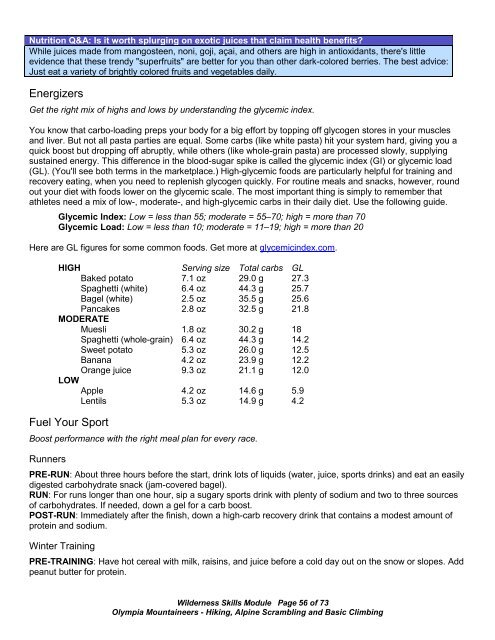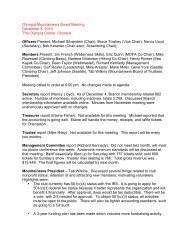Wilderness Skills - Olympia Mountaineers
Wilderness Skills - Olympia Mountaineers
Wilderness Skills - Olympia Mountaineers
Create successful ePaper yourself
Turn your PDF publications into a flip-book with our unique Google optimized e-Paper software.
Nutrition Q&A: Is it worth splurging on exotic juices that claim health benefits?<br />
While juices made from mangosteen, noni, goji, açai, and others are high in antioxidants, there's little<br />
evidence that these trendy "superfruits" are better for you than other dark-colored berries. The best advice:<br />
Just eat a variety of brightly colored fruits and vegetables daily.<br />
Energizers<br />
Get the right mix of highs and lows by understanding the glycemic index.<br />
You know that carbo-loading preps your body for a big effort by topping off glycogen stores in your muscles<br />
and liver. But not all pasta parties are equal. Some carbs (like white pasta) hit your system hard, giving you a<br />
quick boost but dropping off abruptly, while others (like whole-grain pasta) are processed slowly, supplying<br />
sustained energy. This difference in the blood-sugar spike is called the glycemic index (GI) or glycemic load<br />
(GL). (You'll see both terms in the marketplace.) High-glycemic foods are particularly helpful for training and<br />
recovery eating, when you need to replenish glycogen quickly. For routine meals and snacks, however, round<br />
out your diet with foods lower on the glycemic scale. The most important thing is simply to remember that<br />
athletes need a mix of low-, moderate-, and high-glycemic carbs in their daily diet. Use the following guide.<br />
Glycemic Index: Low = less than 55; moderate = 55–70; high = more than 70<br />
Glycemic Load: Low = less than 10; moderate = 11–19; high = more than 20<br />
Here are GL figures for some common foods. Get more at glycemicindex.com.<br />
HIGH<br />
Serving size Total carbs GL<br />
Baked potato 7.1 oz 29.0 g 27.3<br />
Spaghetti (white) 6.4 oz 44.3 g 25.7<br />
Bagel (white) 2.5 oz 35.5 g 25.6<br />
Pancakes 2.8 oz 32.5 g 21.8<br />
MODERATE<br />
Muesli 1.8 oz 30.2 g 18<br />
Spaghetti (whole-grain) 6.4 oz 44.3 g 14.2<br />
Sweet potato 5.3 oz 26.0 g 12.5<br />
Banana 4.2 oz 23.9 g 12.2<br />
Orange juice 9.3 oz 21.1 g 12.0<br />
LOW<br />
Apple 4.2 oz 14.6 g 5.9<br />
Lentils 5.3 oz 14.9 g 4.2<br />
Fuel Your Sport<br />
Boost performance with the right meal plan for every race.<br />
Runners<br />
PRE-RUN: About three hours before the start, drink lots of liquids (water, juice, sports drinks) and eat an easily<br />
digested carbohydrate snack (jam-covered bagel).<br />
RUN: For runs longer than one hour, sip a sugary sports drink with plenty of sodium and two to three sources<br />
of carbohydrates. If needed, down a gel for a carb boost.<br />
POST-RUN: Immediately after the finish, down a high-carb recovery drink that contains a modest amount of<br />
protein and sodium.<br />
Winter Training<br />
PRE-TRAINING: Have hot cereal with milk, raisins, and juice before a cold day out on the snow or slopes. Add<br />
peanut butter for protein.<br />
<strong>Wilderness</strong> <strong>Skills</strong> Module Page 56 of 73<br />
<strong>Olympia</strong> <strong>Mountaineers</strong> - Hiking, Alpine Scrambling and Basic Climbing




